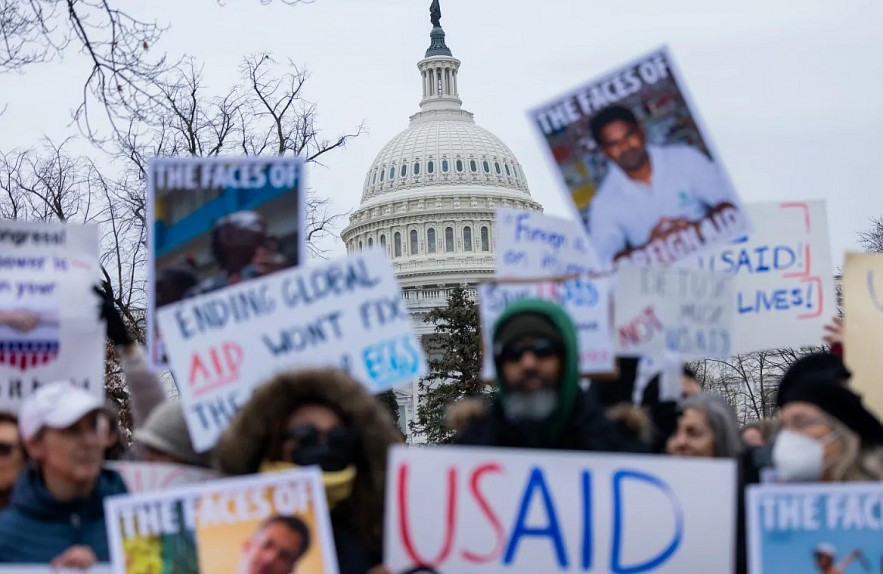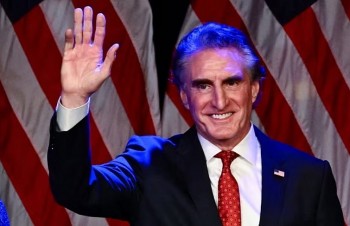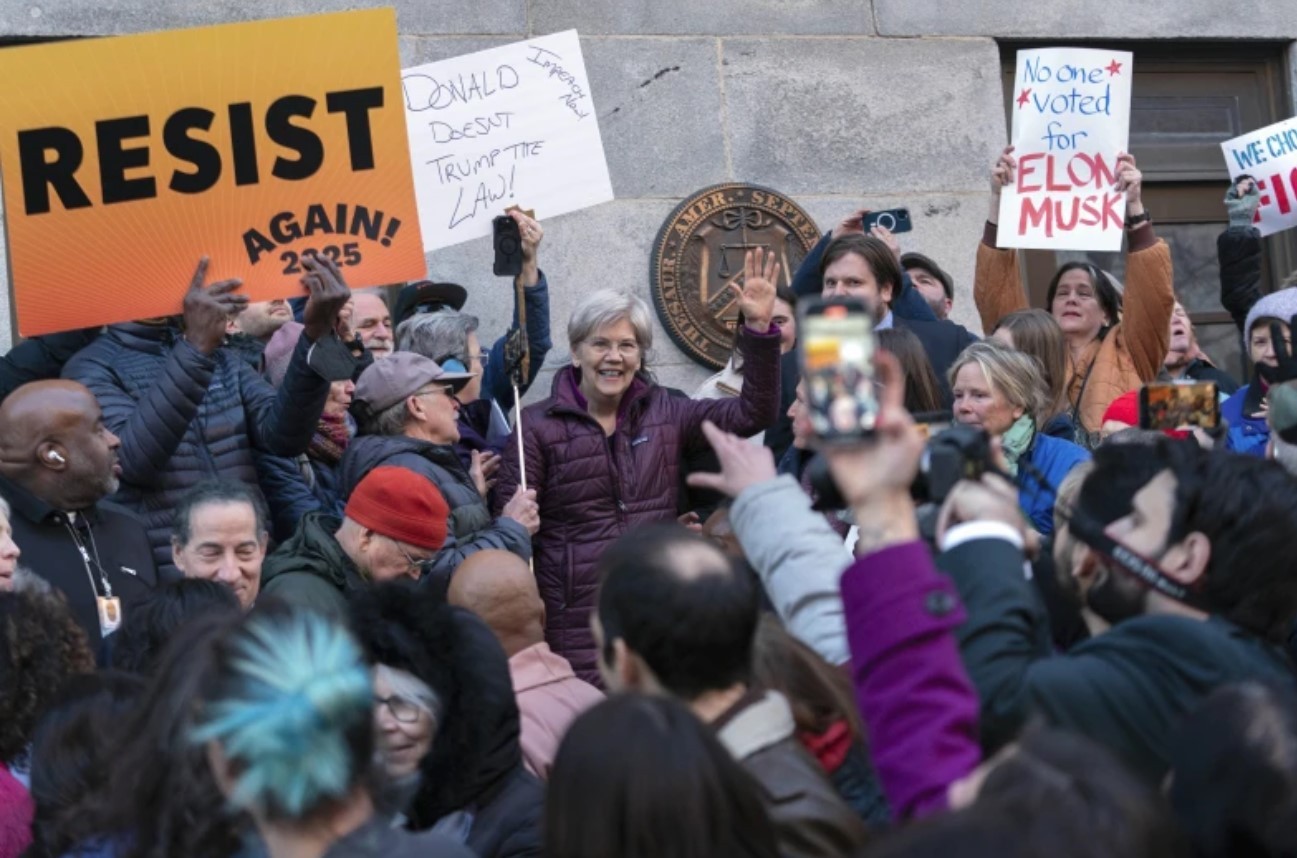How Many Employees Are in the Federal Workforce in the U.S?
 |
| Protestors gather outside of the U.S. Capitol for a rally in support of USAID in Washington, DC |
The federal workforce in the United States is one of the largest employers in the nation, with approximately 2.3 million civilian employees as of early 2025. These employees work across various departments and agencies, contributing to the administration and execution of government policies and programs.
This figure excludes active-duty military personnel, which account for another 1.3 million individuals. The federal government’s workforce covers a broad range of occupations, from national security and healthcare to law enforcement and postal services.
Quick Facts:
-
Federal Workforce Size: ~2.3 million civilian employees.
-
Active Duty Military Personnel: ~1.3 million.
-
Deferred Resignation Offer: Eight months’ salary and benefits for voluntary resignations.
-
Return-to-Office Deadline: Immediate implementation with limited exemptions.
-
Employee Response: Over 40,000 resignations as of early February 2025.
-
Email Announcement: Sent January 28, 2025, at 6:04 p.m., subject line: "The Fork in the Road."
The Trump Administration’s Return-to-Office Mandate
On January 20, 2025, President Donald Trump issued an executive order requiring all federal employees to return to in-person work. This directive marked a significant shift from the flexible telework policies that had been in place since the COVID-19 pandemic. Under this mandate, federal agencies were given limited time to transition employees back to their respective duty stations, with exemptions only in rare cases.
The administration justified the order by emphasizing the importance of productivity, accountability, and government efficiency. However, this decision faced immediate resistance from labor unions, employee advocacy groups, and a significant portion of the workforce, many of whom had successfully adapted to remote work.
The Deferred Resignation Program: A Controversial Offer
Federal workers faced a critical decision on February 6, 2025. That date marked the deadline for accepting the Trump administration’s Deferred Resignation program, a voluntary buyout initiative allowing employees to resign while still receiving pay and benefits through September.
The U.S. Office of Personnel Management unexpectedly announced the offer in an email sent at exactly 6:04 p.m. on January 28. The subject line read: "The Fork in the Road." Many employees were caught off guard and initially questioned the legitimacy of the email.
Federal workers were given two stark choices: stay in their positions and accept a new set of "reforms," including a strict return-to-office policy, or reply to the email with "Resign" in the subject line and voluntarily leave their jobs. As an incentive, resigning employees would receive eight months of pay and benefits.
Employees had just over a week to make a life-changing decision, leading to a surge of confusion, anxiety, and frustration within the federal workforce. Reports indicated that by the February 6 deadline, over 40,000 employees had accepted the offer, a move that could significantly impact the functioning of various federal agencies.
| White House officials estimate that 5% to 10% of federal employees will accept the "deferred resignation" offer, potentially saving around $100 billion. By Tuesday morning, just 1% of the workforce—over 20,000 employees—had taken the deal. However, a White House official stated that the number of accepted buyouts is "rapidly increasing," with the largest surge in sign-ups expected within the final 24 hours before the deadline. |
Employee Reactions: Resistance and Adaptation
The response to these policies has been mixed, with widespread concerns raised about work-life balance, family obligations, and commuting costs. Many federal employees argue that remote work had increased productivity and improved efficiency. For those living outside metropolitan areas, returning to in-person work poses logistical and financial challenges.
Federal labor unions have been vocal in their opposition, citing potential violations of employment agreements and work conditions. The American Federation of Government Employees (AFGE) and the National Treasury Employees Union (NTEU) have filed lawsuits challenging the legality of the mandate and the Deferred Resignation program, arguing that these policies unfairly target long-serving employees.
Legal and Operational Challenges
The sudden shift in workforce policies has triggered significant legal debates and administrative hurdles. Lawmakers on both sides of the aisle have expressed concerns about the long-term implications of these measures.
• Legal Concerns: Opponents argue that the administration may have overstepped its authority in enforcing a broad return-to-office mandate without congressional approval.
• Government Efficiency: With tens of thousands of resignations, critical agencies, including the Department of Veterans Affairs and the Internal Revenue Service, could face staffing shortages that delay essential services.
• Budgetary Considerations: While reducing the workforce might lower government spending in the short term, the loss of experienced personnel may necessitate costly rehiring and retraining efforts.
What Comes Next?
As the legal battles unfold, it remains to be seen whether the Trump administration will amend its policies in response to employee pushback. Federal agencies are currently working to manage the transition, but the long-term effects on government efficiency and employee morale are uncertain.
For now, federal employees must weigh their options carefully—return to their offices under potentially unfavorable conditions or accept a buyout and seek employment elsewhere.
FAQs
1. What is the Deferred Resignation program?
-
It is a voluntary buyout initiative offering federal employees eight months of salary and benefits if they resign by February 6, 2025.
2. Are all federal employees required to return to in-person work?
-
Yes, except for a limited number of exemptions granted by agency heads.
3. What legal actions have been taken against these policies?
-
Federal employee unions have filed lawsuits challenging the legality of the return-to-office mandate and the Deferred Resignation program.
4. How will these policies affect government services?
-
The loss of experienced personnel may cause delays in essential government services, including tax processing, healthcare administration, and public safety operations.
5. What are the potential long-term effects?
-
The changes could lead to a restructuring of federal employment policies, increased turnover rates, and shifts in government hiring practices.
 Who is Lee Zeldin - EPA Chief? Military Service, Personal Life, Career, And Net Worth Who is Lee Zeldin - EPA Chief? Military Service, Personal Life, Career, And Net Worth President-elect Donald Trump has tapped former Rep. Lee Zeldin to lead the Environmental Protection Agency. This article delves into Zeldin’s background, career, personal life, and ... |
 Who is Self-Made Billionaire Doug Burguum (Interior Secretary): Personal Life, Education, Career, And Net Worth Who is Self-Made Billionaire Doug Burguum (Interior Secretary): Personal Life, Education, Career, And Net Worth Doug Burgum, a self-made billionaire, former tech entrepreneur, and North Dakota governor, will balance energy development, conservation, and public land management for the nation's future ... |
 Donald Trump's New Education Policies: Backing School Choice and Empowering Parents Donald Trump's New Education Policies: Backing School Choice and Empowering Parents President Donald Trump signed a sweeping executive order aimed at expanding school choice and strengthening parents' role in their children’s education. |
 Nationalities Most Affected by Trump's Mass Deportations: Who Are the 11 Million Migrants? Nationalities Most Affected by Trump's Mass Deportations: Who Are the 11 Million Migrants? No complete list of those deported by nationality in 2025 has been made public by the U.S. government. However, according to estimates from the Pew ... |
























